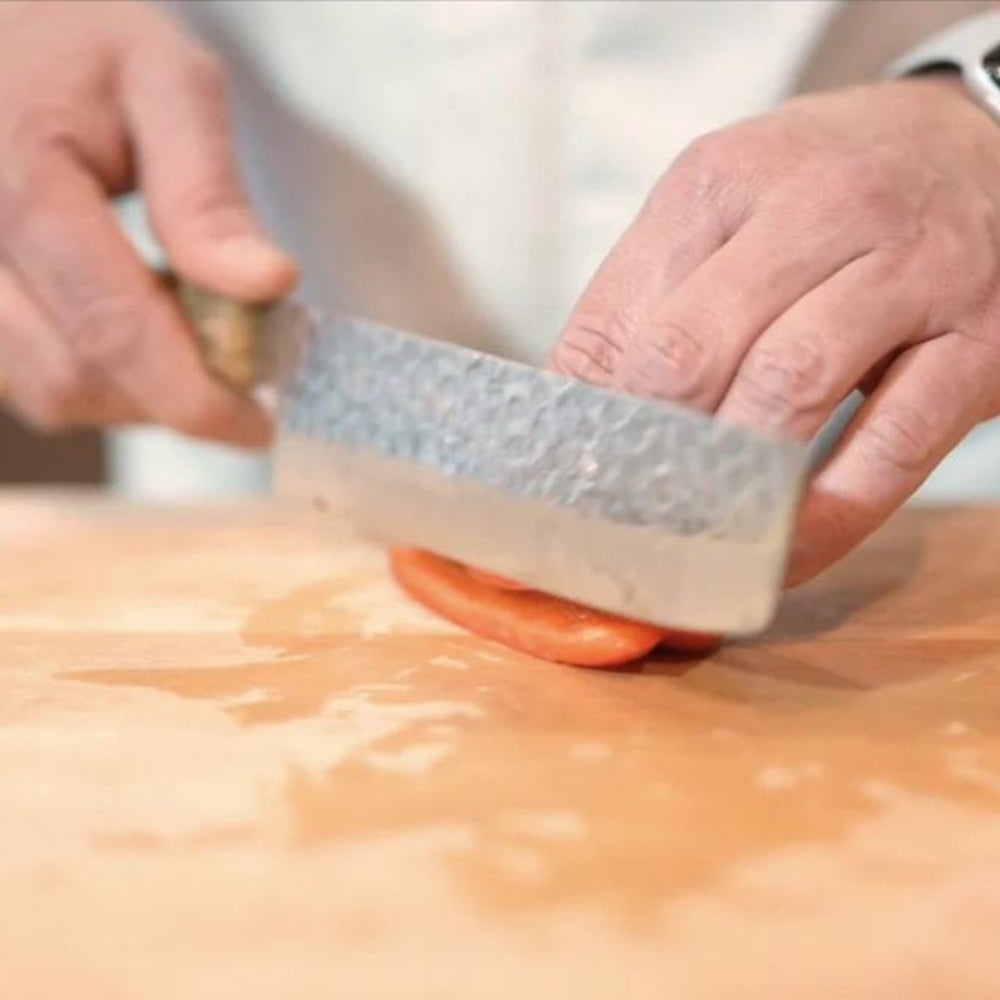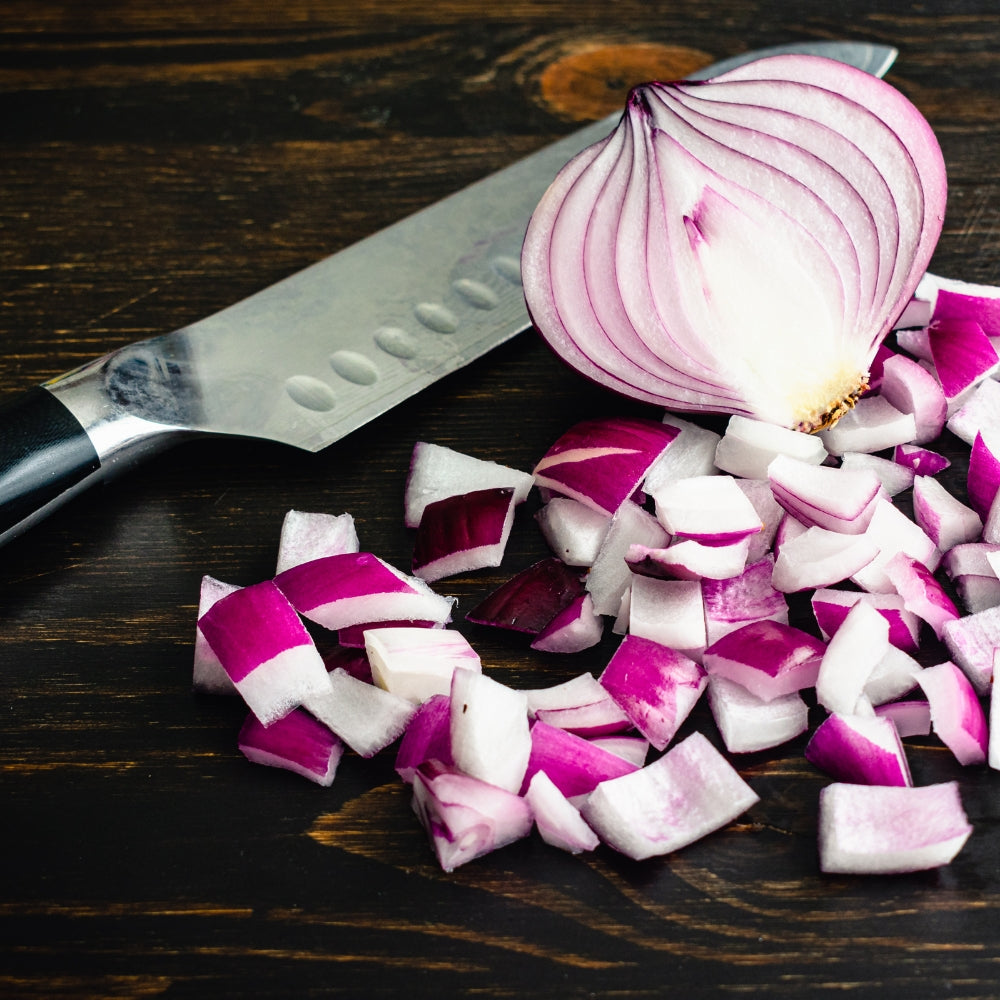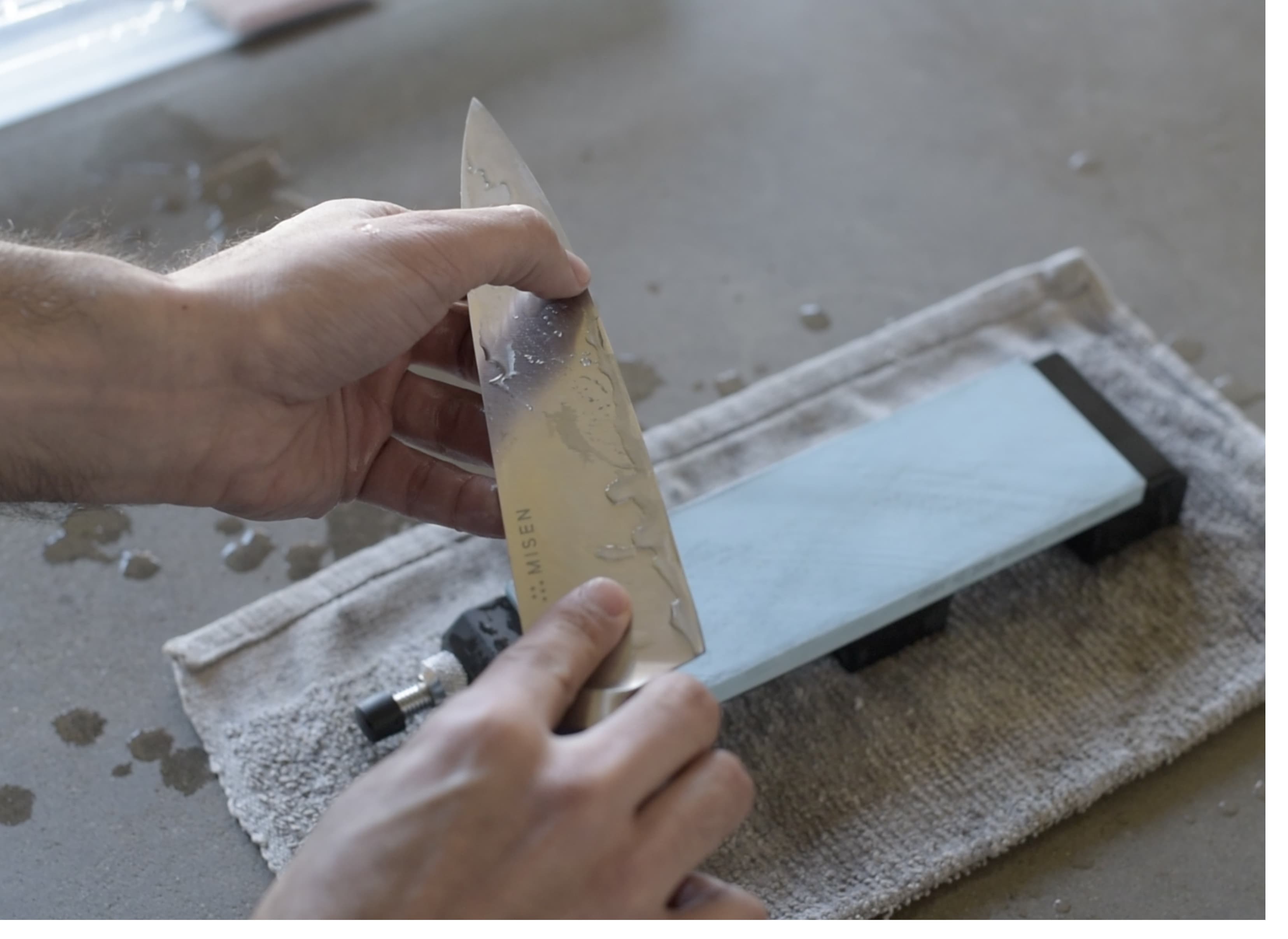
Decoding the Kitchen: Nakiri Knife vs Chef Knife Showdown
By Kenny Trusnik
Senior Food Writer at Pro Home Cooks
Ever been mesmerized by the dance of a professional chef's hands as they wield their knife, effortlessly slicing and dicing? If you're a kitchen enthusiast, you might have pondered about the magic in their blade. Well, here's a secret: it’s not just skill—it’s also about having the right tool for each task.
Nakiri knife vs chef knife: two culinary titans on opposite ends of the cutting spectrum. The former is your samurai warrior when battling an army of vegetables—its sleek Japanese design gives precision cuts every time. On other hand, there's no match for versatility like our ever-dependable chef knife—an all-rounder that embraces everything from mincing garlic to deboning chicken.
Let's look into the distinct characteristics of these blades and find out why some might be more suitable for your culinary requirements than others.
Ready to elevate your culinary game? Dive deeper into our top picks and discover the best in cookware. Check out our assortment kitchen knives now!
Table Of Contents:
- Understanding Nakiri Knife: Features and BenefitsThe Unique Design of the Nakiri Knife
- Nakiris vs Other Knives?
- Making Your Kitchen Experience Better With A Nakiri Knife
- Advantages of Using Chef KnivesVersatility and Broad Applications
- Slicing, Mincing, Chopping - All with One Knife.
- Difference Between Chef Knife and Nakiri Knife
- Blade Design Comparison Between Nakiri Knives and Chef KnivesStraight Vs Curved Blades
- Nakiri Knife vs Chef Knife Comparison Based on Blade Shape
- Cutting Techniques & Applications For Each Knife TypeNakiri Knives
- Chef's Knives
- Material & Maintenance Of Both KnivesStainless Steel vs Carbon Steel Knives
- Maintenance Tips For Your Kitchen Knives
- Size & Weight Differences Between Nakiri Knife and Chef KnifeThe Petite Nakiri Knife
- Chef's Knife: A Heavier Contender
- How Size & Weight Impact Your Cooking Experience
- Price Range And Availability Of Both Types Of Knives
- Investment Considerations For Your Kitchen Knife Purchase
- FAQs in Relation to Nakiri Knife vs Chef Knife
- Conclusion
Understanding Nakiri Knife: Features and Benefits
There's something about a Nakiri knife that just screams precision. It's not your average kitchen blade - it's a Japanese vegetable knife designed to chop, slice, and dice veggies with utmost finesse. The rectangular blade shape paired with the straight edge design ensures every cut is as clean as can be.
The Unique Design of the Nakiri Knife
If you're looking at this thing thinking 'that tip looks odd,' well, you'd be right. Unlike other knives where pointy tips are all the rage for piercing or cutting meat, this one has a squared-off tip that gives you more control over each cut. It feels satisfying to handle.
You see those ragged cuts on tomatoes or cucumbers? Poorly sharpened blades often result in ragged cuts on fruits and vegetables, but our beloved Nakiri ensures each slice retains its flavor and juiciness. But thanks to its straight blade edge, our beloved Nakiri makes sure each slice retains its juices and flavor intact – talk about preserving food integrity.
Prolonged use of any tool could lead to hand fatigue but here's where things get interesting; due to an even weight distribution along the length of the blade, handling this gem becomes quite easy - another reason why home cooks love it so much.
Nakiris vs Other Knives?
In comparison with traditional chef knives commonly used in western kitchens, there are certain benefits that using nakiris offer over others. One such advantage includes how effortlessly these blades glide through vegetables without needing downward pressure, thereby reducing potential risks associated with slippage during usage.
Apart from the safety aspects considered by reduced exertion while cutting, they also provide exceptional precision because unlike some alternatives which rock back-and-forth when used on flat surfaces due to their curved construction, nakiris remain steady, offering consistency across slices whether thin or thick.
Making Your Kitchen Experience Better With A Nakiri Knife
If prepping veggies takes center stage in your kitchen tasks, then having specialized tools like nakiri will definitely enhance your cooking experience. You'll not only appreciate the efficiency it brings forth but also enjoy creating uniform pieces leading towards better texture and presentation of final dishes.
We're not just making things better, we're taking them to the next level.
Imagine having a Nakiri knife in your kitchen. It's all about precision and control. This Japanese veggie whiz gives you clean cuts every time - goodbye to ragged edges. Its balanced weight makes it easy to handle, so your hand won't tire out. And unlike regular chef knives that need downward pressure and might slip, the straight-edged Nakiri just sails through.
Advantages of Using Chef Knives
The chef knife is not a newcomer to the kitchen scene. But, it's often overlooked in favor of more specialized knives like the Nakiri knife. The truth is, this all-purpose knife has an impressive range of applications that can outshine even its most sophisticated counterparts.
Chef knives are just as capable at slicing through juicy tomatoes as they are at mincing delicate herbs or chopping up sturdy root vegetables. Their cutting edge design and balanced weight make them a versatile tool for any home cook.
Versatility and Broad Applications
Akin to your favorite pan that handles every recipe with grace, chef knives take on diverse culinary tasks effortlessly. Their curved blade makes rocking motions easy while their broad size helps scoop chopped ingredients right off the board.
When you reach for your chef’s knife, rest assured knowing it will deliver precise slices without hassle because it was designed with such versatility in mind.
Slicing, Mincing, Chopping - All with One Knife.
Just like non-stick pans lose their charm over time due to high-heat cooking or improper washing; other types of kitchen tools may also falter under repeated use. However, when handled correctly a well-loved chef's knife only gets better with each task performed.
This multi-purpose workhorse improves its performance day by day whether used for disjointing large cuts of meat or dicing onions into fine pieces without causing tears.
Difference Between Chef Knife and Nakiri Knife
In contrast to shorter specialized vegetable choppers like Nakiri knives; these longer blades offer leverage while cutting tough items thereby reducing effort significantly from your end.
Besides being heavier than lightweight Nakiri ones which might struggle during heavy-duty jobs; chef’s knives provide excellent control making them ideal for demanding tasks such as deboning chicken or filleting fish.
Consider the chef knife as your kitchen's Swiss Army knife. It doesn't just slice and dice, it also effortlessly minces herbs, chops veggies, and debones chicken. This versatile tool outperforms specialized knives like the Nakiri when it comes to wide-ranging tasks. Keep this in mind:
Blade Design Comparison Between Nakiri Knives and Chef Knives
First things first, the blade design of both nakiri knives and chef knives is influenced by their cultural origins. The structure of these two blades varies significantly, with one crafted from stainless steel or carbon steel and the other possessing a straight-edged design.
The straight-edged blade of a nakiri knife is perfect for making precise vertical cuts with no need for horizontal motion. This flat edge makes chopping vegetables a breeze. On the flip side, you have your chef's knife which features a curved blade ideal for rocking motions during cutting tasks.
The curvature of this type of blade provides an advantage when mincing or slicing through large pieces like meat or hard-skinned produce. So if you're after versatility in your cooking adventures, then a chef’s knife could be your go-to tool.
Straight Vs Curved Blades
Digging deeper into the differences between these two types of blades reveals more about how they function in various culinary scenarios. The straight edge and thin spine of the nakiri make clean slices through crisp veggies without effort - think julienne cuts or finely diced onions.
In contrast to this precision-focused design is the versatile nature of chefs' knives due to their slightly wider base and convex curve towards the tip.
This unique feature enables smooth back-and-forth rocking action on your cutting board – an essential attribute if speed-chopping techniques are part of your kitchen repertoire.
Nakiri Knife vs Chef Knife Comparison Based on Blade Shape
No matter what kind of recipes you’re looking to tackle—whether traditional Asian dishes with fine vegetable preparations call out to you, or diverse recipes requiring varied cutting methods catch your eye—a clear understanding will guide you in choosing between these distinctly designed tools.
Uncovering the unique traits of nakiri and chef knives shows clear cultural impacts on their blade shapes. The straight-edge, slim-spine nakiri knife excels at precise cuts on crunchy veggies. But, the curved, broad-base chef's knife is a champ for varied cutting methods. So whether you're chopping onions or mincing meat, getting to know these
Cutting Techniques & Applications For Each Knife Type
Have you ever considered how the design of your knife influences its cutting technique? Let's discuss chef’s knives and nakiri knives. While they may just be kitchen tools, each one brings a unique charm to your cooking experience.
Nakiri Knives
The Japanese have a talent for creating exceptional products, and the Nakiri knife is no exception. Its straight blade is not just a fashion statement; it requires an up-and-down motion for effective use. The result? Thin, perfect slices of vegetables every time you cut into them.
If precision is your priority in the kitchen, then this knife should definitely be a part of your toolkit. Not only does it effortlessly slice through produce without damaging delicate cells (looking at you, tomatoes and cucumbers), but it also offers excellent control thanks to its balanced weight distribution.
Chef's Knives
In contrast, chef’s knives take things up a notch with their curved blades, enabling rocking motions while cutting. This is ideal for tasks like mincing herbs or dicing onions. But their versatility doesn't end there; these workhorses can handle everything from disjointing large cuts of meat to crushing garlic cloves with their broad sides.
Beyond being Jacks-of-all-trades in food prep tasks, chef’s knives provide leverage during cuts, reducing hand fatigue over prolonged periods. This is something that nakiri knives do not offer, especially during extensive food preparation sessions.
Don’t let anyone tell you otherwise: whether Nakiri knives or Chef’s knives rule supreme depends on what kind of cook YOU are.
If precision-focused vegetable prep makes your heart sing, go for Nakiri knives with their straight edge magic. But if versatile functionality takes center stage in your culinary world, say hello to Chef’s knives.
So the next time you reach for that utensil drawer, remember: Choose wisely.
When it comes to picking between a Nakiri knife and a Chef's knife, think about how you cook. Love crafting delicate, thin veggie slices? The straight-edged Nakiri is for you. But if you need one tool that can do it all - from dicing herbs to smashing garlic cloves - then go for the curved-bladed Chef's knife.
Material & Maintenance Of Both Knives
Nakiri and Chef's knives are two kitchen workhorses that often don't receive the attention they deserve. Knives made from either stainless steel or carbon steel offer different advantages.
Stainless Steel vs Carbon Steel Knives
Stainless steel knives, similar to lightweight pans, provide ease of maintenance and impressive durability. They are incredibly tough and resistant to rust and stains, making them an obvious choice for many home cooks.
In contrast, carbon steel blades embody the qualities you love about well-seasoned cast iron skillets, but in the form of a knife. They offer superior sharpness and excellent edge retention, improving with each use. Think of them as high-quality non-stick pans that get better over time.
Maintenance Tips For Your Kitchen Knives
Caring for your knives may seem daunting at first, given the abundance of information on proper maintenance. Though it may seem intimidating, proper knife care need not be complicated.
All types of kitchen knives require some tender loving care immediately after use. Cleaning them with warm soapy water effectively removes any residue, and thorough drying prevents moisture damage. Additionally, regular honing using a sharpening rod helps maintain the blade's edge between professional sharpenings, which should be done annually depending on usage levels.
Now, let's talk about those Chef's knives we mentioned earlier. Despite their general durability, they actually require more skillful maintenance practices. This includes honing the blade at correct angles based on design specifications, typically around 15 degrees per side for Western-style chef's knives.
On the other hand, Nakiri users can appreciate the precision vegetable cuts achieved with these straight-edged Japanese style blades. The same care procedures apply, including immediate drying, careful storage methods, routine home-based honing, and less frequent full-on sharpenings done professionally.
So, whether you're using stainless steel or carbon steel knives, remember this mantra: Clean, Dry, Hone, Repeat. Let those beauties shine in your kitchen.
Keeping your Nakiri and Chef's knives in top shape is as important as the material they're made from. Stainless steel gives you durability and fights off rust, while carbon steel delivers exceptional sharpness that gets even better with use. No matter what you choose, don't forget to clean 'em up, dry 'em out, hone 'em down regularly and get a pro to sharpen them once a year for peak performance. Show these kitchen champs some serious love just like
Size & Weight Differences Between Nakiri Knife and Chef Knife
Hello, cooking enthusiasts. Today, we're going to delve into the world of knives and compare the nakiri knife and the chef knife. An essential factor to bear in mind is the heft and size of these blades, as they can significantly influence your cooking experience.
The Petite Nakiri Knife
The nakiri knife can be likened to a compact car in the kitchen. It typically measures between 5 to 7 inches in length, striking a balance between being not too big and not too small. This size is perfect for maneuvering quickly when you need to make intricate vegetable cuts.
Despite its lightweight design, this Japanese gem is incredibly functional. It excels at precision tasks like julienning carrots or finely chopping herbs. However, it's important to note that larger food items may pose a challenge due to the smaller blade size.
Chef's Knife: A Heavier Contender
In contrast, let's consider the heavyweight champion - the versatile chef's knife. Typically ranging from 8 to 10 inches in length, this knife is well-suited for handling various ingredients, including large vegetables and meat cuts.
The additional weight of the chef's knife may require some adjustment if you're used to lighter tools. However, many cooks find that the added power behind each chop significantly speeds up their prep time. It's worth mentioning that comfort is crucial in the kitchen, so those with smaller hands or less experience may prefer more petite options.
How Size & Weight Impact Your Cooking Experience
In summary, when choosing between the nakiri knife and the chef knife, it's important to consider size comparisons, weight comparisons, and personal preference. The size and weight differences directly influence how effectively you can control these essential kitchen tools. Hence, it's essential to pick a blade that fits comfortably in your grasp - this will upgrade your culinary experience and make your delightful dishes even more pleasant.
Imagine a culinary boxing match, with the agile nakiri knife squaring off against the robust chef's knife. The compact and lightweight Nakiri shines when it comes to swift precision cuts, but might falter with bigger ingredients. Conversely, the Chef’s Knife brings power and adaptability to your kitchen counter - although its weight can make it trickier for some cooks to wield. So, as you pick out your kitchen hero...
Price Range And Availability Of Both Types Of Knives
All right, folks. When you're in the market for a new kitchen knife, your wallet might have some opinions too. It's an investment consideration that can't be ignored. So let's talk about Nakiri and Chef's knives - their price ranges and where to snag one.
Nakiri knives are Japanese originals with prices typically ranging from $30 to $200. These knives aren't just found anywhere though; you'll need to check out specialty stores selling Japanese cutlery or browse online platforms like Amazon.
On the flip side, Chef's knives offer a wider price spectrum because they're loved worldwide. You could get lucky and find options under $20, but if high-end is more your style, then prepare for over $300.
The best part? You won't break a sweat finding these bad boys since they're available almost everywhere - department stores, kitchenware shops, and e-commerce websites galore.
Investment Considerations For Your Kitchen Knife Purchase
But wait, there's more. A new knife isn't just about how much it costs up front – longevity and maintenance play their parts too. Quality blades made of materials like high-carbon steel may last longer, but keep in mind that regular honing or professional sharpening services add up over time.
Your cooking habits should also weigh into this decision between Nakiri versus Chef's knife: If chopping veggies is your jam, then investing in a Nakiri could be worth every penny due to its design aimed at precise cuts without damaging those greens.
If versatility is what tickles your fancy, then perhaps spending on a well-rounded chef's knife would make sense since it excels at diverse tasks ranging from slicing meat to mincing herbs.
FAQs in Relation to Nakiri Knife vs Chef Knife
What is a nakiri knife best used for?
Nakiri knives excel at chopping vegetables, thanks to their straight edge and thin blade. They make precise cuts without damaging delicate veggies.
Are Nakiri knives worth it?
Absolutely. If you often prepare vegetables, the precision and ease of use that a Nakiri knife offers make it an excellent kitchen investment.
Is a nakiri knife a chef knife?
No, they're different tools. A Nakiri is designed specifically for cutting vegetables while Chef's knives are versatile multi-taskers suitable for various food items.
Can I use a nakiri knife for meat?
You can technically cut meat with any sharp blade, but the design of the Nakiri knife isn't ideal for this task; its forte lies in vegetable preparation.
Conclusion
Unveiling the secrets of the kitchen can be an enlightening journey.
The nakiri knife vs chef knife debate brings to light how each blade's unique design and purpose serves different culinary needs.
We've seen that Nakiris, with their straight edge and rectangular shape, are precision masters when it comes to slicing vegetables.
On the other hand, Chef knives take versatility up a notch with their curved blades tackling everything from mincing garlic to deboning chicken effortlessly.
Differences in material, maintenance requirements, size, and weight add more layers to this comparison.
Your choice between these two ultimately depends on your cooking style and preference for maneuverability or versatility.
Whether you decide on a Nakiri or a Chef knife - or both! - remember that proper care will extend its lifespan while maintaining optimal performance. Happy chopping!
Transform your kitchen experience with the best cutlery handpicked by Mike. Don't miss out on these essentials. Check out our top selections now!
TOP ARTICLES

Sourdough Baking School
Master the art of sourdough bread baking in the most comprehensive baking class on the internet. This class features over three hours of baking content to help you start your sourdough journey.
See More



